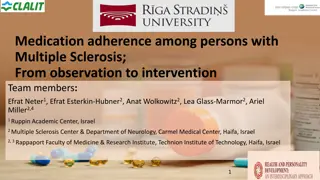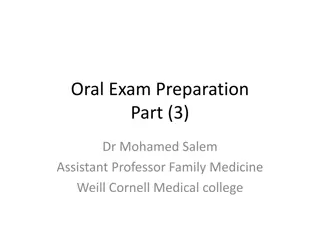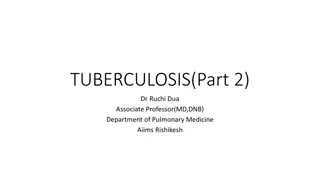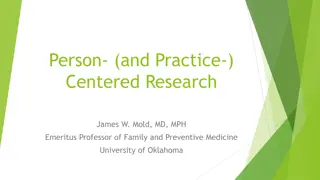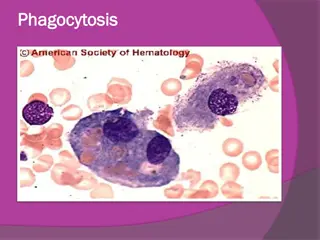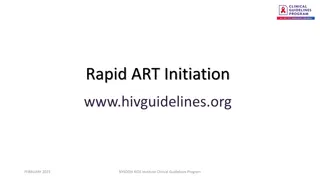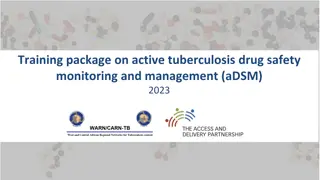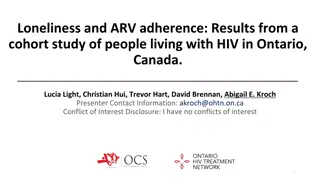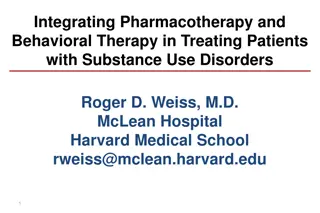Ethics of Tuberculosis Care: Supporting Adherence and Patient-Centered Approaches
This module emphasizes the ethical importance of promoting adherence to TB treatment, highlighting challenges faced by patients and the need for patient-centered care. Strategies such as Directly Observed Therapy (DOT) are discussed as ethically justifiable ways to improve treatment adherence while respecting patient autonomy.
Download Presentation

Please find below an Image/Link to download the presentation.
The content on the website is provided AS IS for your information and personal use only. It may not be sold, licensed, or shared on other websites without obtaining consent from the author. Download presentation by click this link. If you encounter any issues during the download, it is possible that the publisher has removed the file from their server.
E N D
Presentation Transcript
Ethics of Tuberculosis Prevention, Care and Control MODULE 6: SUPPORTING ADHERENCE TO TB TREATMENT [INSERT SPEAKER NAME DATE & LOCATION HERE] Insert country/ministry logo here 1
Objectives Upon completion of this module, you will be able to: Identify strategies for promoting adherence to treatment Discuss ethical issues around adherence to treatment 2 USAID TB CARE II PROJECT
Ethical basis for promoting adherence to TB treatment Providers have obligations to patient and public to support patient s ability to adhere to treatment People with TB have ethical duty to complete therapy However, completing TB treatment can be difficult for patients: Lost wages and impacts (food, supporting family etc.) Stigma Side effects Partnership is key to success! 3 USAID TB CARE II PROJECT
Patient-Centred Care Patient-centred care reflects a partnership among practitioners and patients to ensure that decisions respect patients wants, needs, and preferences and that patients have the education and support they need to make decisions and participate in their own care. Patient-centered approaches recognise that care is provided along a continuum of services O Donnell MR, Daftary AD, Frick M, Hirsch-Moverman Y, Amico KR, Sentilingham M, Wolf A, Metcalfe JZ, Isaakidis P, Davis L, Brust JCM, Naidoo N, Garretson M, Zelnick JR, Bangsberg D, Padayatchi N, Friedland G. Consensus statement on behalf of the attendees of the Re-inventing adherence: patient-centered care for drug-resistant TB and HIV , March 19, 20, 2015, Columbia Mailman School of Public Health, Columbia University, New York, NY, USA USAID TB CARE II PROJECT
Directly observed therapy (DOT) May improve adherence to treatment Benefits of DOT can include: Minimising the burden of care on patient Reducing indirect costs of care, such as time lost from work Providing encouragement and support for patients Opportunity for early detection and management of side effects 5 USAID TB CARE II PROJECT
Directly observed therapy (DOT) - 2 Ethically justifiable when done as part of a patient-centred approach to care: Take steps to avoid the stigmatisation of patient Give patient choices about who will observe them and where observation will take place Clearly explain what will happen if patient is non- adherent Implement mechanisms to promote early detection and proper management of side-effects DOT should be process for providing support, motivation, and understanding to patients 6 USAID TB CARE II PROJECT
Promoting adherence through use of incentives and enablers - 1 Enablers refer to mechanisms or resources that facilitate patients ability to adhere to treatment Examples include: Taxi/bus fare Food baskets Incentives refer to small rewards to encourage patients to adhere to TB treatment by motivating them with something they want or need Examples include: Cash payment Clothing 7 USAID TB CARE II PROJECT
Promoting adherence through use of incentives and enablers - 2 Use of incentives and enablers can help mitigate the impact of the social determinants of TB Create opportunities to stay in touch with health care workers or DOT supporters Empower patients to take an active role in their care Promote ethical value of autonomy Should be chosen according to patient s needs and interests Must be provided in an equitable and non- discriminatory way 8 USAID TB CARE II PROJECT
Promoting adherence through use of incentives and enablers -3 When to offer: Enablers: May be vital to the initiation of treatment and should be provided as soon as treatment starts Incentives: Best time to begin using incentives is after a good relationship has been established with patient 9 USAID TB CARE II PROJECT
Lets discuss incentives and enablers . PLENARY What, if any enablers or incentives have you employed to encourage adherence? For each of these, what are the trust or ethical concerns identified, and how can these be managed? 10 USAID TB CARE II PROJECT
Use of incentives for completing treatment: Summary Benefits Society provide something in return for individual who accepts burden for benefit of community (ethical principle of reciprocity) Risks Could seem inappropriate, even insulting, attempt to buy the patient s cooperation May overlook broader, and ultimately more valuable efforts to address root causes of non-adherence] Provision of incentives should be based on: Expected efficacy of practice Sensitivity to local norms May undermine important efforts in other areas of public health May prevent full disclosure of patient concerns, issues due to fear of losing incentives 11 USAID TB CARE II PROJECT
Ethical considerations regarding non- adherence - 1 Ethical obligation to follow up with patients who are having problems with adherence Demonstrates commitment to: Promoting the individual patient s best interests Need to protect others in the community from the risks of untreated TB 12 USAID TB CARE II PROJECT
Ethical considerations regarding non- adherence - 2 Efforts to contact patients must be carried out in a way that minimises intrusions At initiation of treatment, patients should be: Informed that they will be contacted if they do not keep appointments Given a choice about the process by which communication will take place 13 USAID TB CARE II PROJECT
Response to non-adherence Try a different approach Try to identify most effective methods and best practices to promote adherence Reconsider overall approach to treatment, especially if non-adherence is on large scale This may indicate system issues that must be improved *Remember the ethical principle of autonomy* 14 USAID TB CARE II PROJECT
Denying treatment to individuals based on predictions about non-adherence No evidence that non-adherence can be accurately predicted Specific reasons that may impede adherence should be addressed as part of initial discussions about treatment Distinguish from situations in which conditions in a particular setting are inadequate to support TB programme at all 15 USAID TB CARE II PROJECT
Providers ethical obligations when treatment fails Fundamental ethical obligation to avoid abandoning patients for who treatment is not working Obligation of non-abandonment requires provision of palliative care Location of care based on an individualised risk assessment Individual s degree of infectiousness Willingness and ability to comply with infection-control precautions Presence of children in the home Preparation and training of community care providers 16 USAID TB CARE II PROJECT
17 USAID TB CARE II PROJECT




